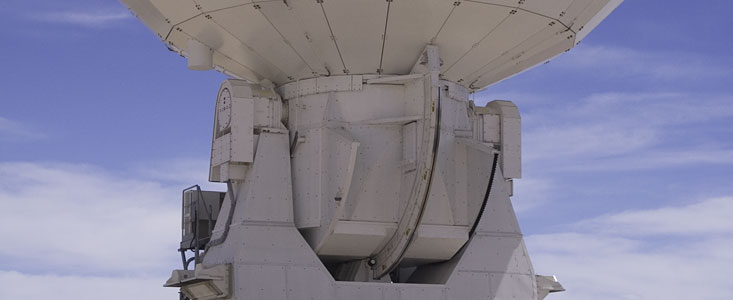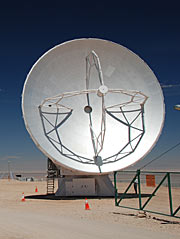Komunikat prasowy
ALMA observatory equipped with its first antenna
18 grudnia 2008

High in the Atacama region in northern Chile, one of the world's most advanced telescopes has just passed a major milestone. The first of many state-of-the-art antennas has just been handed over to the Atacama Large Millimeter/submillimeter Array (ALMA) project. ALMA is under construction on the plateau of Chajnantor, at an altitude of 5000 m. The telescope is being built by a global partnership, including ESO as the European partner.
ALMA will initially comprise 66 high precision antennas, with the option to expand in the future. There will be an array of fifty 12-metre antennas, acting together as a single giant telescope, and a compact array composed of 7-metre and 12-metre diameter antennas.
With ALMA, astronomers will study the cool Universe — the molecular gas and tiny dust grains from which stars, planetary systems, galaxies and even life are formed. ALMA will provide new, much-needed insights into the formation of stars and planets, and will reveal distant galaxies in the early Universe, which we see as they were over ten billion years ago.
The first 12-metre diameter antenna, built by Mitsubishi Electric Corporation for the National Astronomical Observatory of Japan, one of the ALMA partners, has just been handed over to the observatory. It will shortly be joined by North American and European antennas.
"Our Japanese colleagues have produced this state-of-the-art antenna to exacting specifications. We are very excited about the handover because now we can fully equip this antenna for scientific observations," said Thijs de Graauw, ALMA Director.
Antennas arriving at the ALMA site undergo a series of tests to ensure that they meet the strict requirements of the telescope. The antennas have surfaces accurate to less than the thickness of a human hair, and can be pointed precisely enough to pick out a golf ball at a distance of 15 km.
"ALMA is very important to European astronomers and to ESO, the European partner in this project, because it allows us to look at the Universe in a way that has never been possible before. It really marks the start of a new era in astronomy," said Wolfgang Wild, the European ALMA Project Manager.
This antenna handover is a major milestone, as the observatory team can now proceed with integrating the rest of the components, including the sensitive receivers that will collect the faint cosmic signals from space.
The antennas are tested at the Operations Support Facility, at an altitude of 2900 m, before being moved to the plateau of Chajnantor at 5000 m. The Operations Support Facility will also be the observatory's control centre.
ALMA is being built on the Chajnantor plateau, high in the Chilean Andes, because the site's extreme dryness and altitude offer excellent conditions for observing the submillimetre-wavelength signals for which the telescope is designed.
In addition, the wide plateau at Chajnantor offers ample space for the construction of the antenna array, which is spread out and linked together over distances of more than 16 kilometres.
"The ALMA antennas must withstand the harsh conditions at Chajnantor with strong winds, cold temperatures and a thin atmosphere with half as much oxygen as at sea level. This forbidding environment also poses challenges for the workers building ALMA," said de Graauw.
The antennas, which each weigh about 100 tons, can be moved to different positions in order to reconfigure the ALMA telescope. This will be carried out by two custom-designed transporters, each of which is 10 metres wide, 20 metres long, and has 28 wheels (eso0732).
The ALMA Project is a partnership between the scientific communities of East Asia, Europe and North America with Chile.
Uwagi
ALMA will be the leading astronomical instrument for observing the cool Universe – the molecular gas and dust that constitute the building blocks of stars, planetary systems, galaxies and of life itself.
ALMA will operate at wavelengths of 0.3 to 9.6 mm. At these wavelengths, a high, dry site is needed for the telescope to be able to see through the Earth's atmosphere. This is why ALMA is being built on the 5000 m high plateau of Chajnantor in the Atacama region of Chile. ALMA will offer unprecedented sensitivity and resolution. The 12-metre antennas will have reconfigurable baselines ranging from 15 m to 16 km. Resolutions as fine as 0.005 arcseconds will be achieved at the shortest wavelengths – a factor of ten better than the Hubble Space Telescope.
The ALMA project is a partnership between Europe, Japan and North America in cooperation with the Republic of Chile. ALMA is funded in Europe by ESO, in Japan by the National Institutes of Natural Sciences in cooperation with the Academia Sinica in Taiwan and in North America by the U.S. National Science Foundation in cooperation with the National Research Council of Canada. ALMA construction and operations are led on behalf of Europe by ESO, on behalf of Japan by the National Astronomical Observatory of Japan and on behalf of North America by the National Radio Astronomy Observatory, which is managed by Associated Universities, Inc.
Linki
Kontakt
Wolfgang Wild
ESO
Garching, Germany
Tel.: +49 89 3200 6716
E-mail: wwild@eso.org
Thijs de Graauw
Joint ALMA Observatory
Paranal, Chile
Tel.: +56 2 467 6120
E-mail: tdegraau@alma.cl
Douglas Pierce-Price
ESO
Garching, Germany
Tel.: +49 89 3200 6759
E-mail: dpiercep@eso.org
Valentina Rodriguez
ESO
Garching, Germany
Tel.: +56 2 463 3123
E-mail: vrodrigu@eso.org
O komunikacie
| Komunikat nr: | eso0849 |
| Legacy ID: | PR 49/08 |
| Nazwa: | Atacama Large Millimeter/submillimeter Array |
| Typ: | Unspecified : Technology : Observatory : Telescope |
| Facility: | Atacama Large Millimeter/submillimeter Array |
Our use of Cookies
We use cookies that are essential for accessing our websites and using our services. We also use cookies to analyse, measure and improve our websites’ performance, to enable content sharing via social media and to display media content hosted on third-party platforms.
ESO Cookies Policy
The European Organisation for Astronomical Research in the Southern Hemisphere (ESO) is the pre-eminent intergovernmental science and technology organisation in astronomy. It carries out an ambitious programme focused on the design, construction and operation of powerful ground-based observing facilities for astronomy.
This Cookies Policy is intended to provide clarity by outlining the cookies used on the ESO public websites, their functions, the options you have for controlling them, and the ways you can contact us for additional details.
What are cookies?
Cookies are small pieces of data stored on your device by websites you visit. They serve various purposes, such as remembering login credentials and preferences and enhance your browsing experience.
Categories of cookies we use
Essential cookies (always active): These cookies are strictly necessary for the proper functioning of our website. Without these cookies, the website cannot operate correctly, and certain services, such as logging in or accessing secure areas, may not be available; because they are essential for the website’s operation, they cannot be disabled.
Functional Cookies: These cookies enhance your browsing experience by enabling additional features and personalization, such as remembering your preferences and settings. While not strictly necessary for the website to function, they improve usability and convenience; these cookies are only placed if you provide your consent.
Analytics cookies: These cookies collect information about how visitors interact with our website, such as which pages are visited most often and how users navigate the site. This data helps us improve website performance, optimize content, and enhance the user experience; these cookies are only placed if you provide your consent. We use the following analytics cookies.
Matomo Cookies:
This website uses Matomo (formerly Piwik), an open source software which enables the statistical analysis of website visits. Matomo uses cookies (text files) which are saved on your computer and which allow us to analyze how you use our website. The website user information generated by the cookies will only be saved on the servers of our IT Department. We use this information to analyze www.eso.org visits and to prepare reports on website activities. These data will not be disclosed to third parties.
On behalf of ESO, Matomo will use this information for the purpose of evaluating your use of the website, compiling reports on website activity and providing other services relating to website activity and internet usage.
Matomo cookies settings:
Additional Third-party cookies on ESO websites: some of our pages display content from external providers, e.g. YouTube.
Such third-party services are outside of ESO control and may, at any time, change their terms of service, use of cookies, etc.
YouTube: Some videos on the ESO website are embedded from ESO’s official YouTube channel. We have enabled YouTube’s privacy-enhanced mode, meaning that no cookies are set unless the user actively clicks on the video to play it. Additionally, in this mode, YouTube does not store any personally identifiable cookie data for embedded video playbacks. For more details, please refer to YouTube’s embedding videos information page.
Cookies can also be classified based on the following elements.
Regarding the domain, there are:
- First-party cookies, set by the website you are currently visiting. They are stored by the same domain that you are browsing and are used to enhance your experience on that site;
- Third-party cookies, set by a domain other than the one you are currently visiting.
As for their duration, cookies can be:
- Browser-session cookies, which are deleted when the user closes the browser;
- Stored cookies, which stay on the user's device for a predetermined period of time.
How to manage cookies
Cookie settings: You can modify your cookie choices for the ESO webpages at any time by clicking on the link Cookie settings at the bottom of any page.
In your browser: If you wish to delete cookies or instruct your browser to delete or block cookies by default, please visit the help pages of your browser:
Please be aware that if you delete or decline cookies, certain functionalities of our website may be not be available and your browsing experience may be affected.
You can set most browsers to prevent any cookies being placed on your device, but you may then have to manually adjust some preferences every time you visit a site/page. And some services and functionalities may not work properly at all (e.g. profile logging-in, shop check out).
Updates to the ESO Cookies Policy
The ESO Cookies Policy may be subject to future updates, which will be made available on this page.
Additional information
For any queries related to cookies, please contact: pdprATesoDOTorg.
As ESO public webpages are managed by our Department of Communication, your questions will be dealt with the support of the said Department.






